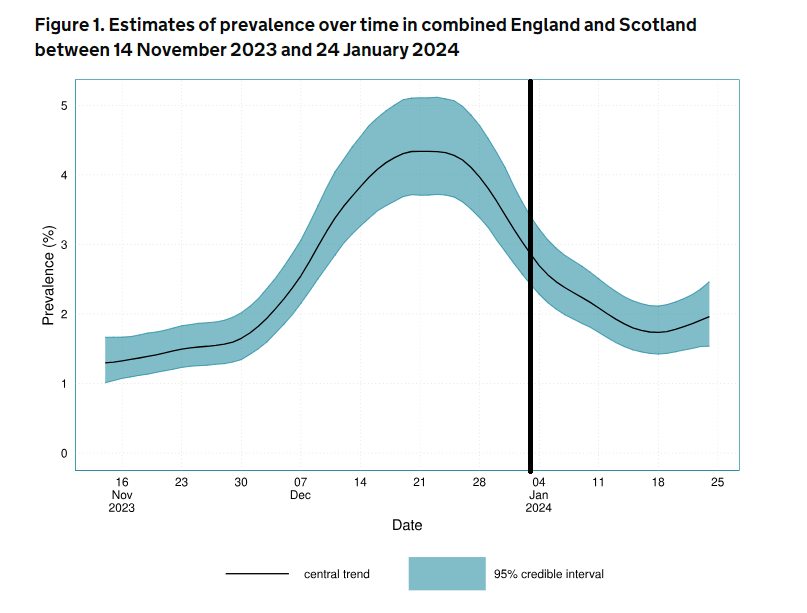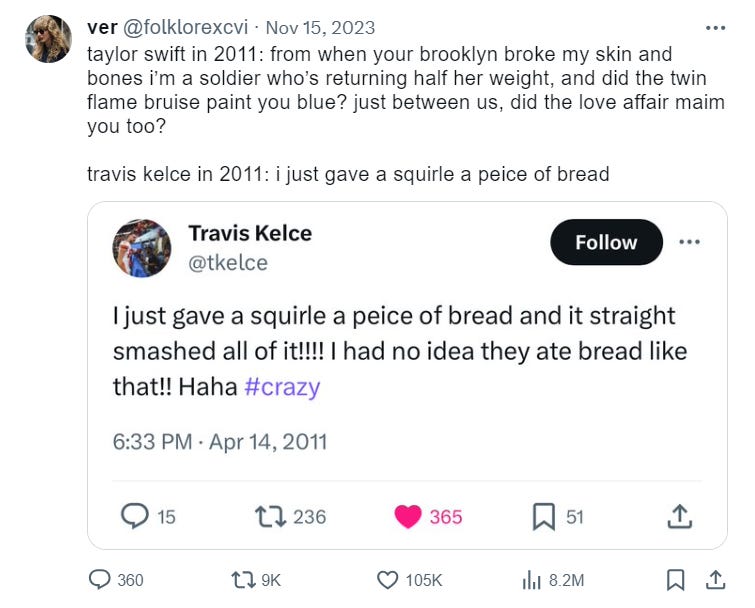A non-mathematical post today, where I try to answer the all-important question “how much money would you want to be paid to repeatedly slam into a wall?”. But before that I wanted to check in with a couple of things.
Very brief COVID update
As I wrote here three weeks ago about the JN.1 wave:
I wouldn’t necessarily expect that you can extrapolate that downwards curve at the same rate - I might well expect something flatter (and possibly even growing slowly) in the coming few weeks.
And that crystal ball gazing seems to have aged fine, as the latest ONS/UKHSA Infection Survey graphs show (the vertical line marks the time of the previous prediction):
Further, as we are comfortably past the peak, it becomes more clear that (as I wrote in the same piece) infections haven’t converted into admissions and deaths at even the rate we saw last year, which is great news. It’s worth reading
‘s deeper dive on this, because he rightly points out that this seems due to a combination of milder infections and a more favourable age profile. But anyway, JN.1 is infecting enough people that it should start to run short on hosts at some stage and there aren’t any other fast-growing variants which have yet reached a decent share, so I’m not expecting very significant rises in admissions for at least a month or two.In-person talks
When I was sitting at home in the dark days of 2020 and 2021, one of the things that kept me going was the thought of returning to normality so that I could go on the road, meet some of my favourite people from COVID Twitter, and give some talks. So now, here are the details of three upcoming talks, all of which are aimed at a general audience, and where it would be lovely to see you:
The Jean Golding Institute DataViz seminar here in Bristol on Wednesday 7th February. (Note: Unfortunately it’s currently showing as sold out, but we are investigating larger rooms - so worth checking back next week).
I’m returning to my roots by speaking at the place which gave me my first academic job. I’m looking forward to revisiting Christ’s College Cambridge, and giving a Lady Margaret Lecture there on Monday 12th February.
Finally, and slightly terrifyingly given the calibre of mathematicians who have previously talked in this series, I’m giving an Oxford Maths Public Lecture on Wednesday 14th February.
I have some more talks on the horizon too, including this one in London on 22nd May, but I’m happy to try to schedule further ones in other places as well if there is interest, and dates permit. Let me know!
Now for something completely different
I wanted to venture a little bit into American politics and culture. On New Year’s Day I wrote about the Ronnie O’Sullivan documentary on Amazon, and I’m following that up with a few brief thoughts about Kelce, their American football documentary.
Unless you’ve been living on the moon, you’ll have probably have read about the romance between singer Taylor Swift and American football player Travis Kelce, which has led to some pretty wild conspiracy theories that the whole thing is being staged by the Pentagon to swing the 2024 Election. It’s worth noting that this documentary is mainly about Travis’s brother Jason, through a season playing for the Philadelphia Eagles, though Travis appears a fair amount as well (not least through the climax of the film in the two brothers’ appearance playing for opposite teams in last year’s Superbowl).
You might have seen Jason through memes and snapshots of his recent appearance in the crowd in Buffalo, braving subzero temperatures a week after Philadelphia had been knocked out of this year’s NFL tournament:
It’s perhaps not everyone’s idea of an athlete at their physical peak (though of course I wouldn’t dare say that to his face!). But I think it’s interesting what the documentary tells us about 21st Century masculinity, and just how far the Republicans have strayed away from what their values used to be.
At first sight from the photo, Jason Kelce maybe seems like an unreconstructed macho guy. But some of the most revealing scenes in the documentary involve him resting up at home and playing with his kids. When he loses the Superbowl, he doesn’t end up in a nightclub drowning his sorrows with fashion models, he lies on a hotel bed and chats to his young daughters and his heavily-pregnant wife.
Indeed, for me the big tension of the film involves the trade-off between him risking injury and wanting to provide for his family. Kelce’s a big guy: Wikipedia tells me that he’s 6 foot 3 and 295 pounds. But he’s also pretty fast: he ran the 40 yard dash at the NFL combine in 4.89 seconds. That’s not record-breaking, but it’s speedy enough by the standards of his position1 (think of a rugby forward). Putting these things together, since momentum is mass times velocity, Jason Kelce running into you at full speed is definitely enough to spoil your day.
And that’s his job. First he has to snap the football to the quarterback, then he has to run as fast as he can into somebody of a similar build to block them. Again and again. Unsurprisingly, this comes with risks. Kelce talks early on about how many bones he has broken, his history of strained ligaments, muscle injuries and so on. But there’s worse too - all the players know by now about the risks of head trauma from these kinds of collisions, raising the long-term risk of dementia and early death.
But because Jason Kelce is good at his job, he is paid handsomely for these risks - his current contract is worth just over $14m per year. And that’s really the dilemma of the film: should he play another season and earn this kind of money again?
On one hand, it seems insane. His past contracts have already earned him tens of millions of dollars, his family would already be rich beyond most peoples’ dreams if he quit. And yet, in the end he decides to keep playing - at least in part from what seems like sincere and mutual love for the supporters of the city that he represents, and for the teammates and comrades that he plays with.
Of course, such documentaries can always be criticised for presenting a one-sided view of their subjects. It’s rare for someone to collaborate with film makers and be completely stitched up by them. But even if this Kelce family public image has been somewhat crafted, it seems ridiculous that the modern GOP would be picking a fight with that image. Kelce is apparently the most successful documentary in the history of Amazon, which suggests a widespread appeal beyond just Philadelphia supporters (and it’s not like Taylor Swift is exactly unpopular with the voting public either).
Indeed, the virtues that Kelce exhibits seem like solid traditionally Republican ones to me. He has worked hard to make the most of his natural talent - he was nobody’s idea of a future star when he was the 191st ranked player in the NFL draft. As I’ve described, he puts in a hard shift to provide for his family, and for all that this family video was attacked by the excitable scolds of social media it looks lovely to me. More than that, as the shirtless photo shows, he seems like an uncomplicated kind of guy who likes to kick back with a beer.
For all the viral tweets poking fun at the differences between the level of eloquence of Taylor Swift and his brother, the Kelce brothers seem happy being who they are. There’s a lot worse role models for young men out there, and it feels to me like they are doing a pretty good job of navigating the expectations around 21st Century gender roles.
Attacking the Kelces and Swift seems a pretty weird fight for the MAGA wing of the Republican party to pick, and is perhaps a symptom of a commentator class who are terminally online. I had been assuming that Trump was favourite to win in November, based on polls of swing states, but actually I’m now starting to wonder. Biden did a pretty good job in 2020 of ignoring the wildest fringes of the Internet, so it’s not impossible that he can win by doing the same this time.
And when the girl
on the bleachers
Dreaming about the day when you wake up and find
That what you're looking for has been here the whole time
might finally be seeing some version of that American Dream coming true, then it’s hard not to think that Trump and his more out-there supporters are playing a strategy which will work fine with hardcore supporters in the primaries but might struggle to carry over to win over undecided centrist voters.
But of course, we’ll see what happens in the General Election, and in the meantime there’s a small matter of another Superbowl to be played first (go 49ers!).
For context, Usain Bolt apparently managed 4.27 seconds. Wide receiver Tyreek Hill, who was a World Junior medallist in the 200m managed something similar.







Thanks for the heads-up about the public talks; hopefully see you in Oxford.
Chapeaux on the post title. Standing ovation.